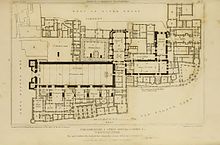
The Parliament of the United Kingdom is the supreme legislative body of the United Kingdom, and may also legislate for the Crown Dependencies and the British Overseas Territories. It meets at the Palace of Westminster, London. It possesses legislative supremacy and thereby ultimate power over all other political bodies in the UK and the overseas territories. While Parliament is bicameral, it has three parts, consisting of the sovereign (King-in-Parliament), the House of Lords, and the House of Commons. In theory, power is officially vested in the King-in-Parliament. However, the Crown normally acts on the advice of the prime minister, and the powers of the House of Lords are limited to only delaying legislation; thus power is de facto vested in the House of Commons.

The Palace of Westminster serves as the meeting place for both the House of Commons and the House of Lords, the two houses of the Parliament of the United Kingdom. Informally known as the Houses of Parliament, the Palace lies on the north bank of the River Thames in the City of Westminster, in central London, England.
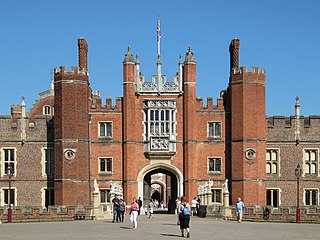
Hampton Court Palace is a Grade I listed royal palace in the London Borough of Richmond upon Thames, 12 miles southwest and upstream of central London on the River Thames.

A speech from the throne, or throne speech, is an event in certain monarchies in which the reigning sovereign, or their representative, reads a prepared speech to members of the nation's legislature when a session is opened, or in some cases closed. The address sets forth the government's priorities for its legislative agenda, for which the cooperation of the legislature is sought. The speech is often accompanied by formal ceremony. It is often held annually, although in some places it may occur more or less frequently, whenever a new session of the legislature is opened.
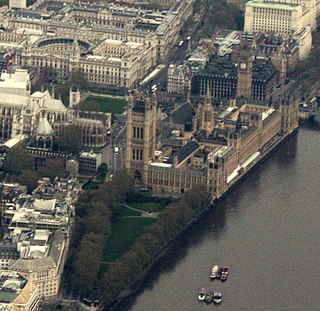
The Parliamentary Estate is the land and buildings used by the Parliament of the United Kingdom.

The Palace of Westminster, the medieval royal palace used as the home of the British parliament, was largely destroyed by fire on 16 October 1834. The blaze was caused by the burning of small wooden tally sticks which had been used as part of the accounting procedures of the Exchequer until 1826. The sticks were disposed of carelessly in the two furnaces under the House of Lords, which caused a chimney fire in the two flues that ran under the floor of the Lords' chamber and up through the walls.

The Palace of Whitehall — also spelled White Hall — at Westminster was the main residence of the English monarchs from 1530 until 1698, when most of its structures, except notably Inigo Jones's Banqueting House of 1622, were destroyed by fire. Henry VIII moved the royal residence to White Hall after the old royal apartments at the nearby Palace of Westminster were themselves destroyed by fire. Although the Whitehall palace has not survived, the area where it was located is still called Whitehall and has remained a centre of the British government.

The State Opening of Parliament is a ceremonial event which formally marks the beginning of a session of the Parliament of the United Kingdom. It includes a speech from the throne known as the King's Speech. The event takes place in the House of Lords chamber on the first day of a new session, which is usually in May or June, and traditionally in November, but can occur at any time of year depending on the timing of General Elections and parliamentary session start dates. It takes place in front of both Houses of Parliament. The monarch, wearing the Imperial State Crown, reads a speech that has been prepared by his or her government outlining its plans for that parliamentary year. The most recent ceremony was held on 10 May 2022.

The Victoria Tower is a square tower at the south-west end of the Palace of Westminster in London, adjacent to Black Rod's Garden on the west and Old Palace Yard on the east. At 98.5 metres (323 ft), it is slightly taller than the Elizabeth Tower at the north end of the Palace. At the time of its construction it was the tallest square tower in the world. It was designed by Charles Barry in the Perpendicular Gothic style and was completed in 1860. It houses the Parliamentary Archives in archive conditions meeting the BS 5454 standard, on 12 floors. All 14 floors of the building were originally linked via a single wrought-iron Victorian staircase of 553 steps, of which five floors survive. The steps are made of granite quarried from Cairngall in Aberdeenshire.

A throne room or throne hall is the room, often rather a hall, in the official residence of the crown, either a palace or a fortified castle, where the throne of a senior figure is set up with elaborate pomp—usually raised, often with steps, and under a canopy, both of which are part of the original notion of the Greek word thronos.

Buda Castle is the historical castle and palace complex of the Hungarian Kings in Budapest. It was first completed in 1265, although the massive Baroque palace today occupying most of the site was built between 1749 and 1769. The complex in the past was referred to as either the Royal Palace or the Royal Castle. The castle now houses the Hungarian National Gallery and the Budapest Historical Museum.

The Jewel Tower is a 14th-century surviving element of the Palace of Westminster, in London, England. It was built between 1365 and 1366, under the direction of William of Sleaford and Henry de Yevele, to house the personal treasure of King Edward III. The original tower was a three-storey, crenellated stone building which occupied a secluded part of the palace and was protected by a moat linked to the River Thames. The ground floor featured elaborate sculpted vaulting, described by historian Jeremy Ashbee as "an architectural masterpiece". The tower continued to be used for storing the monarch's treasure and personal possessions until 1512, when a fire in the palace caused King Henry VIII to relocate his court to the nearby Palace of Whitehall.
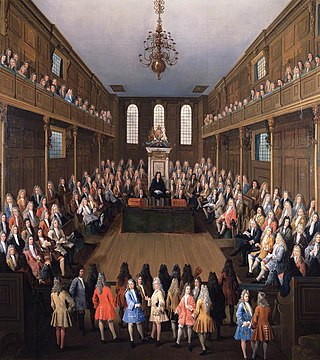
St Stephen's Chapel, sometimes called the Royal Chapel of St Stephen, was a chapel completed around 1297 in the old Palace of Westminster which served as the chamber of the House of Commons of England and that of Great Britain from 1547 to 1834. It was largely destroyed in the fire of 1834, but the Chapel of St Mary Undercroft in the crypt survived.

The Painted Chamber was part of the medieval Palace of Westminster. It was gutted by fire in 1834, and has been described as "perhaps the greatest artistic treasure lost in the fire". The room was re-roofed and re-furnished to be used temporarily by the House of Lords until 1847, and it was demolished in 1851.

Old Palace Yard is a paved open space in the City of Westminster in Central London, England. It lies between the Palace of Westminster to its north and east and Westminster Abbey to its west. It is known as the site of executions, including those of Sir Walter Raleigh, Guy Fawkes and other conspirators of the Gunpowder Plot, and James Hamilton, 1st Duke of Hamilton, following the Battle of Preston.

The Chapel of St Mary Undercroft is a Church of England chapel located in the Palace of Westminster, London, England. The chapel is accessed via a flight of stairs in the south east corner of Westminster Hall.
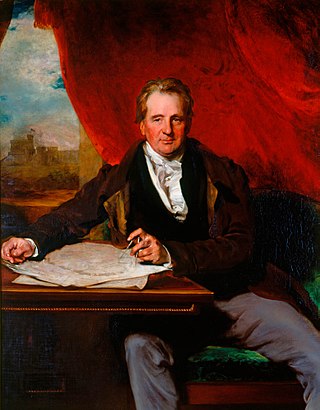
Sir Jeffry Wyatville was an English architect and garden designer. Born Jeffry Wyatt into an established dynasty of architects, in 1824 he was allowed by King George IV to change his surname to Wyatville. He is mainly remembered for making alterations and extensions to Chatsworth House and Windsor Castle.

The State Opening of Parliament includes a State Procession, a formal display of the Sovereign, dignified by a sizeable entourage made up of Great Officers of State, members of the royal family and of the Royal Household. The State Procession is now confined to the interior of the Palace of Westminster, but in earlier centuries it followed an outdoor route to and from Westminster Abbey.

Speaker's House is the official residence of the Speaker of the House of Commons, the lower house and primary chamber of the Parliament of the United Kingdom. It is located in the Palace of Westminster in London. It was originally located next to St Stephen's Chapel and was rebuilt and enlarged by James Wyatt in the early 19th century. After the burning of Parliament in 1834 it was rebuilt by Charles Barry as part of the new Palace of Westminster in the Perpendicular Gothic Revival style. It is located at the northeast corner of the palace and is used for official functions and meetings. Each day, prior to the sitting of the House of Commons, the Speaker and other officials walk in procession from the apartments to the House of Commons Chamber.
The history of the Palace of Westminster began in the Middle Ages - in the early eighth century - when there was an Anglo-Saxon church dedicated to St. Peter the Apostle which became known as the West Minster. In the tenth century the church became a Benedictine abbey and was adopted as a royal church, which subsequently became a royal palace in the 11th century.

